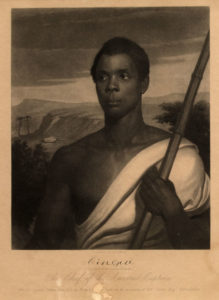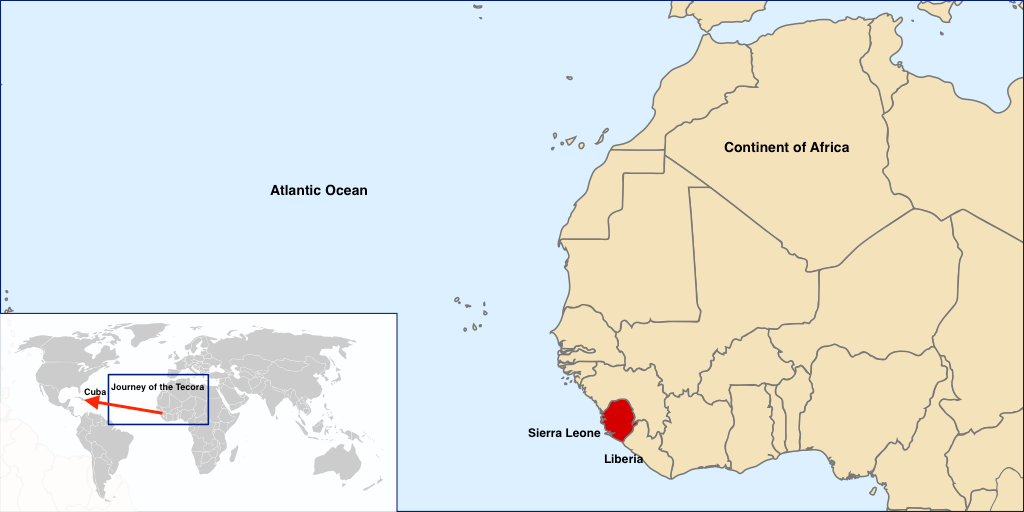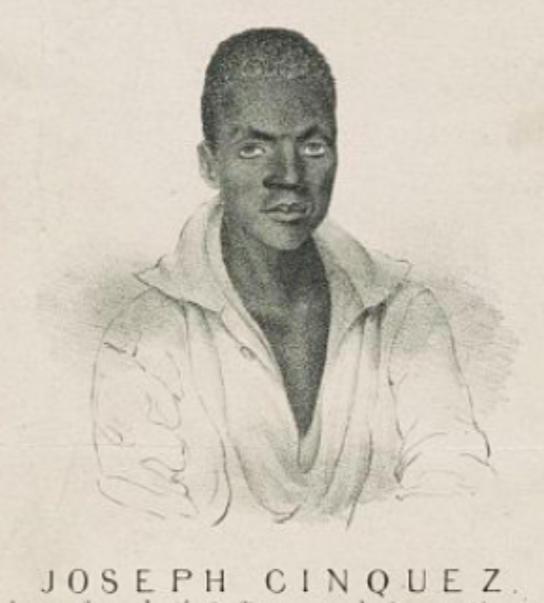The Long Journey of
Sengbe Pieh/Joseph Cinque

Cinque, leader of the Mende people during the Amistad trial.
Joseph Cinque was only in Connecticut for a few years. And that wasn’t his real name. But he is an important person in our state’s history.
Sengbe Pieh was born in 1814 in the village of Mani in West Africa. He was a member of the Mende tribe. His father was a leader in the village. Sengbe learned from his father so that perhaps he could grow up to be a leader.
The Mende people are a large tribe in Sierra Leone and Liberia. Sierra Leone and Liberia are in West Africa. They are both on the Atlantic Ocean. The Mende are an important group of people in West Africa today.
Sengbe grew up and got married. He and his wife had three children. He was a rice farmer like most people in his village.
Kidnapped!
The Ley were another tribe in Sierra Leone. Sengbe owed money to a Ley man. In January 1839, Sengbe and others from his village were kidnapped by the Ley. He was separated from his family. He didn’t know what happened to them.
Sengbe and the other captives were forced to march to the coast. It took days. There, a Spanish slave trader bought Sengbe. He bought people from other tribes, too, who had been kidnapped. Some of the captives were children.
 The Africans were put on a ship called The Tecora. The ship sailed across the Atlantic Ocean to Cuba. It was a long and horrible journey. Sengbe and the other captives suffered hunger, sickness, beatings, and death. Those who died were thrown overboard. Sengbe was strong. He survived the long journey.
The Africans were put on a ship called The Tecora. The ship sailed across the Atlantic Ocean to Cuba. It was a long and horrible journey. Sengbe and the other captives suffered hunger, sickness, beatings, and death. Those who died were thrown overboard. Sengbe was strong. He survived the long journey.
When The Tecora arrived in Cuba, the captain lied. He said that the captives on his ship were all born in Cuba. He lied because the international slave trade was illegal. But it was legal to sell enslaved people born in Cuba. Sengbe was now called Cinque. Cinque means five in Spanish.
Don Jose Ruiz and Don Pedro Montez owned a plantation on Cuba. They needed slaves to work for them. They purchased Cinque and 52 other Africans. The Africans were put on a ship called the Amistad to sail around the island to the plantation.
In the middle of the journey, the Africans were able to get free. They revolted and took control of the ship. Cinque lead the revolt.
Freedom Again for Sengbe

Sengbe Pieh, now called Joseph Cinque. Library of Congress
After the trial in Connecticut, Cinque returned to his home in Sierra Leone. But when he got there, he could not find his family. His village had been destroyed. His family may also have been taken and sold into slavery. Cinque was heart broken. Little is known about what he did during the remaining years of his life. He had to start over. He was not yet 30 years old. All we know is that he died in 1879. He was 65 years old. He is buried in Sierra Leone.
Cinque was described as a man of courage. He showed this during his long journey to America and back home. He was a leader who fought for his freedom. He also fought for the freedom of his fellow Africans. He inspired many Americans to continue to work to end slavery in America.
Many thanks to Kari Nicewander upon whose essay for the West Hartford Public Schools this is based.
Sources:
Douglas Linde, Cinque Biography, University of Missouri
Robin Roy, Amistad Documents, Center Church Historian, Hartford, 2016
Jesse Greenspan, The Amistad Slave Rebellion, History Channel, A&E Networks, 2014
Encyclopedia Britannica, Mende People



 The Africans were put on a ship called The Tecora. The ship sailed across the Atlantic Ocean to Cuba. It was a long and horrible journey. Sengbe and the other captives suffered hunger, sickness, beatings, and death. Those who died were thrown overboard. Sengbe was strong. He survived the long journey.
The Africans were put on a ship called The Tecora. The ship sailed across the Atlantic Ocean to Cuba. It was a long and horrible journey. Sengbe and the other captives suffered hunger, sickness, beatings, and death. Those who died were thrown overboard. Sengbe was strong. He survived the long journey.